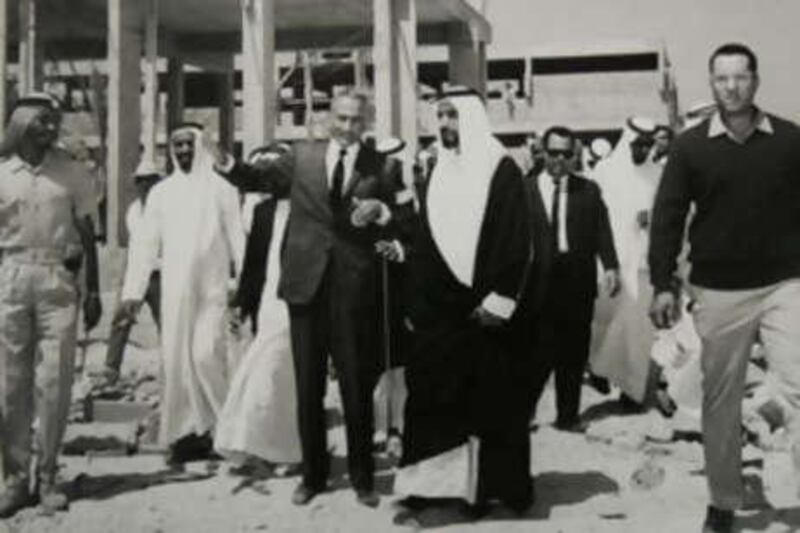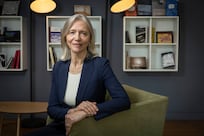ABU DHABI // A decade or more before the first sprawling malls appeared in the capital, the central souq gave heart and soul to a city that was still little more than a desert settlement. In 200 shops connected by shaded paths, merchants met all the needs of shoppers, offering a wide selection of fresh food and spices as well as carpets, clothing and jewellery. The project was the brainchild of Sheikh Zayed and the capital's first town planner, Abdel Rahman Makhlouf.
The late President had the clearest of visions for the souq: the provision of shop space for Emiratis to display their creativity, develop sources of income and contribute to the beginnings of a commercial economy. When it opened in 1970, it quickly established itself as much more than a market, serving equally as a vibrant meeting place where deals were done and ideas exchanged. But as the modernisation of Abu Dhabi gathered pace, the city grew rapidly around its small souq and, with its tall buildings and wide roads, came to overshadow it. Decline set in and by the time a fire destroyed much of the souq in 2002, it was so derelict that many felt its disappearance was to be welcomed.
Six years later, a new central souq is rising from the ashes. The foundations have been laid and the complex - to be known as Abu Dhabi's Central Market - will open in 2011. Located at the junctions of Khalifa Street, Hamdan Street and Airport Road, it will extend across six hectares of the city centre, with a recreation of a traditional souq forming part of an ambitious development that will also offer up-to-the-minute shopping, a leisure area, a modern shopping area, green space, cafes, an entertainment venue, a mosque and three glass towers housing office and residential units, a luxury hotel and parking space for almost 6,000 cars.
If Abu Dhabi's old souq is gone, its memory will be kept alive by the new development. According to Norman Foster and Partners, the British firm of architects responsible for the design, strenuous efforts have been made to reproduce the original market's charm while meeting 20th century needs. "When we were invited to look at the project we were shown all the historic material about the site," said Gerard Evenden, senior partner at the firm.
"It was clear this was extremely important in terms of the development of the city. Not just for shopping, but as a social space; this is the heart of the city." Working with Aldar Properties, Foster and Partners redesigned the site with the aim of bringing all the principles of the original souq into a modern context. Ousama Ghannoum, media director at Aldar, said everything possible was being done to keep the ambience and colour of a traditional souq, but without the slightly chaotic qualities of a bazaar.
"Spices, gold, carpets, handicrafts, things you could buy at the old souq will still be here in the old souq part of this project," Mr Ghannoum said. "This is not a large space, we kept it small. We used wood to maintain the spirit of the traditional souq." Separated from the "old souq" by two towers that will dominate the development, the new shopping area will be a multi-storey complex, targeting upmarket shoppers with the full range of stores they find in smart modern malls.
Although clearly excited by the luxurious features of the new shopping area, the architects are adamant that visitors will notice major differences from other malls and mixed-use developments in the country - unique qualities that will be explored in the forthcoming architectural edition of Shawati', the quarterly cultural magazine. "This could have been another mall," Mr Evenden said. "But what we're doing is very different; this is about having a place where you can discover things. It's about building a development that has its immediate community connected to it.
"The transition as you move through it is one of discovery. The building blends together. So at one end you have a traditional souq, then you move through it to a central area where the gold and silver souq begins." While largely indoors, he said the Central Market would use light, patterns and shadows to create the illusion of walking through city streets. Many of the capital's residents are excited by the project; the souq - perhaps the most striking feature of an Arab city after its mosques - is about to get a bold new facelift.
But there is dissent. Now 84, Mr Makhlouf, who still regards the original souq as "my baby", has deep reservations. "The towers, why?" he asked. "Maybe they have something, but it's not going to be historical. It won't have the flavour, the scent." Mr Makhlouf said the design should have taken account of the importance of a souq's symbolism in Arab culture. "Studying history is key to planning," he said. "It is very important to save some of the features of history."
However, Mr Evenden insists that the Central Market will accomplish that. "The building is specific to Abu Dhabi," he said. "It responds to Abu Dhabi's climate, the culture of the city. It's not a pastiche of something that's trying to recreate the past. This is a very modern interpretation, we're bringing all the principles of the original souq and all souqs in the region into a modern context. That is unlike any other development in the world."
Those convinced by the argument say the Central Market is a much needed development. "The old souq was dilapidated. It didn't offer anything to the city," said Ayad Abbas, a management consultant who has lived and worked in Abu Dhabi since 1982. "This change is a leap forward. There couldn't have been a positive change with the old souq. "But change is important. Change is the only permanent thing in life."
@Email:jhume@thenational.ae






